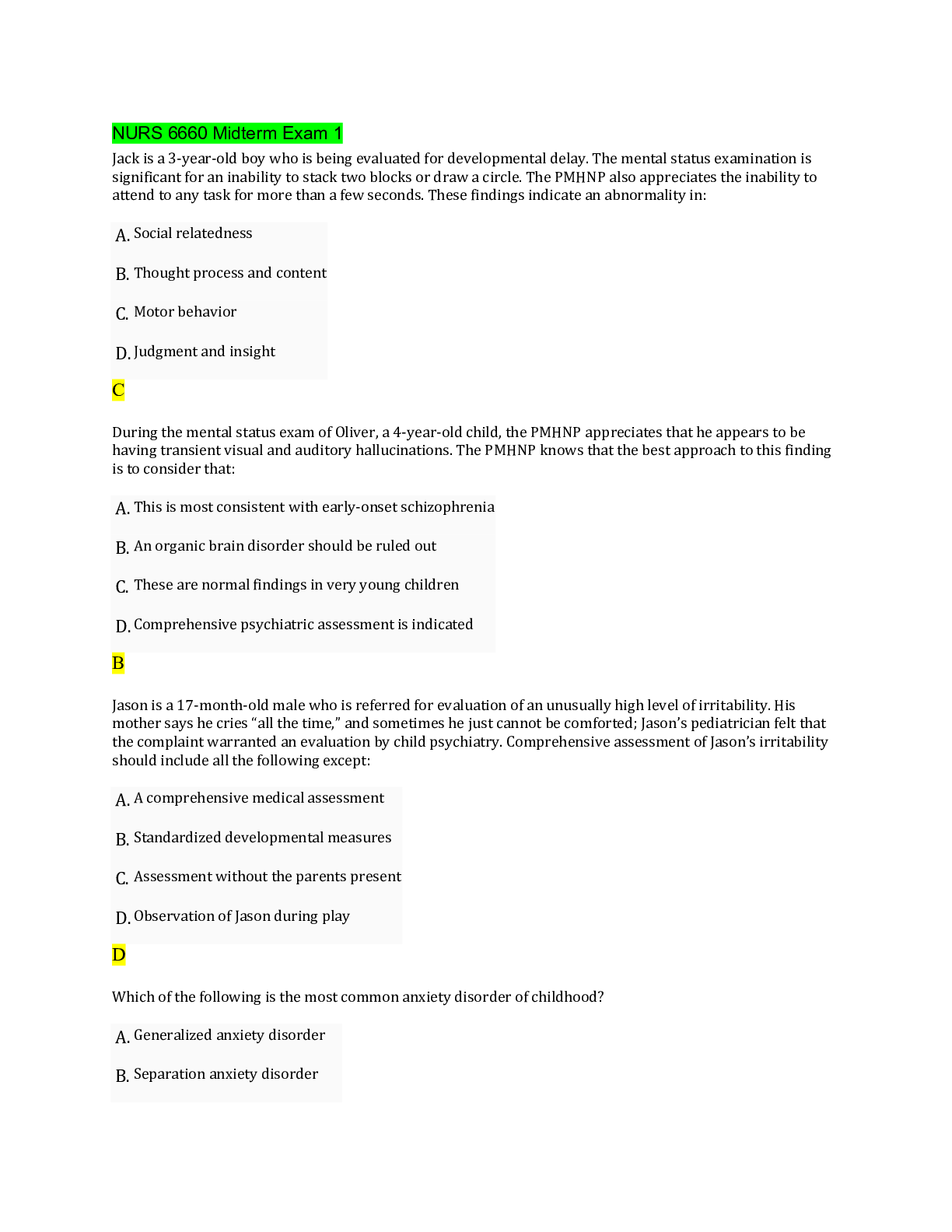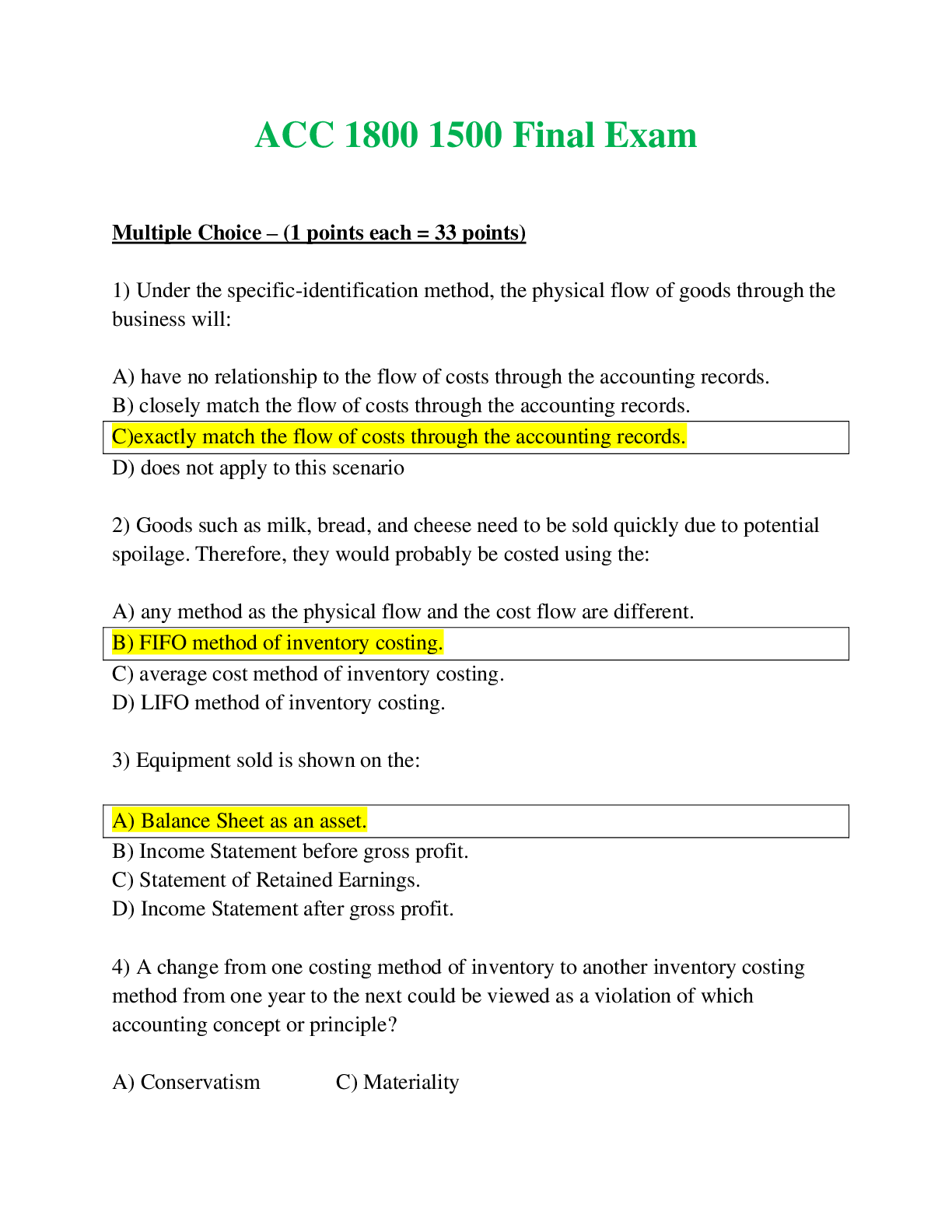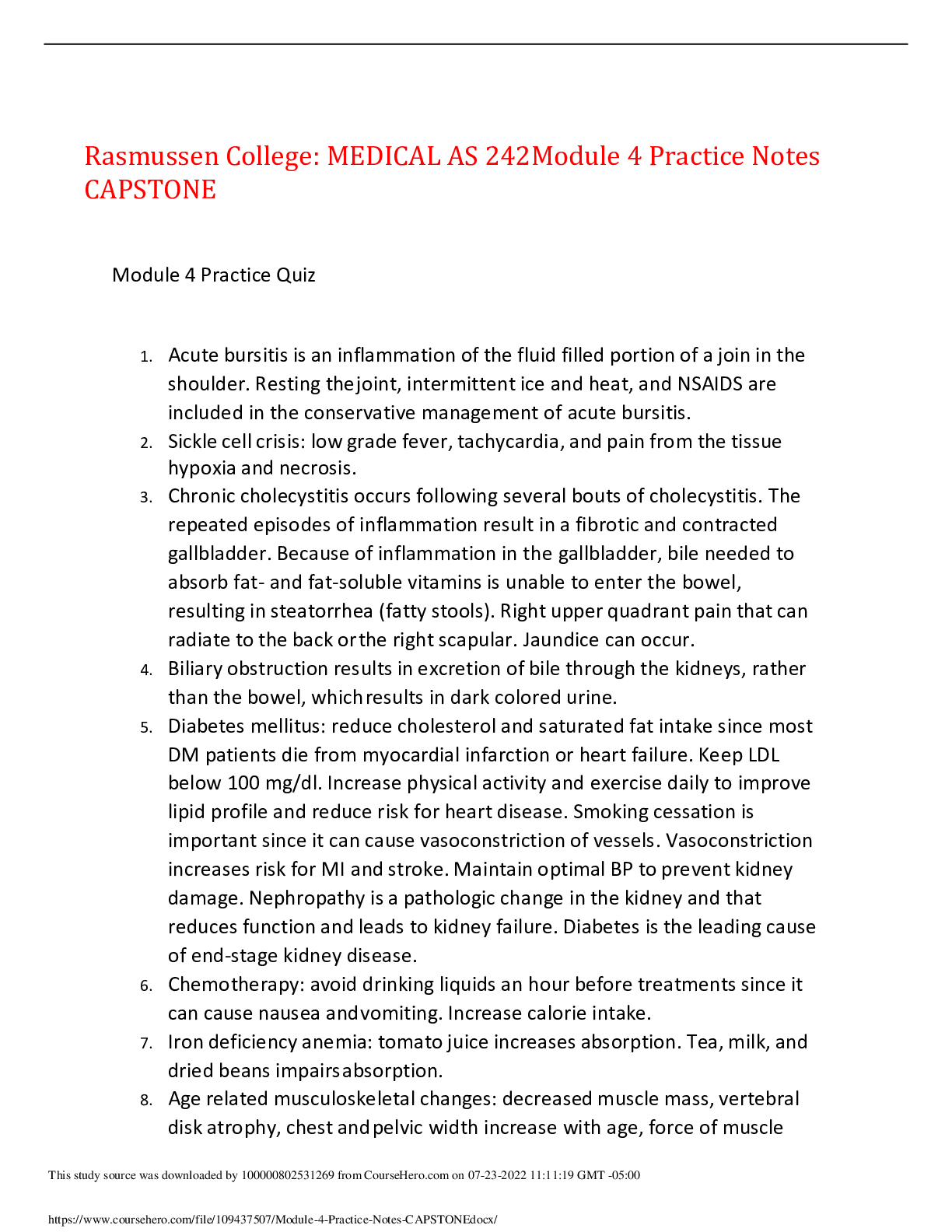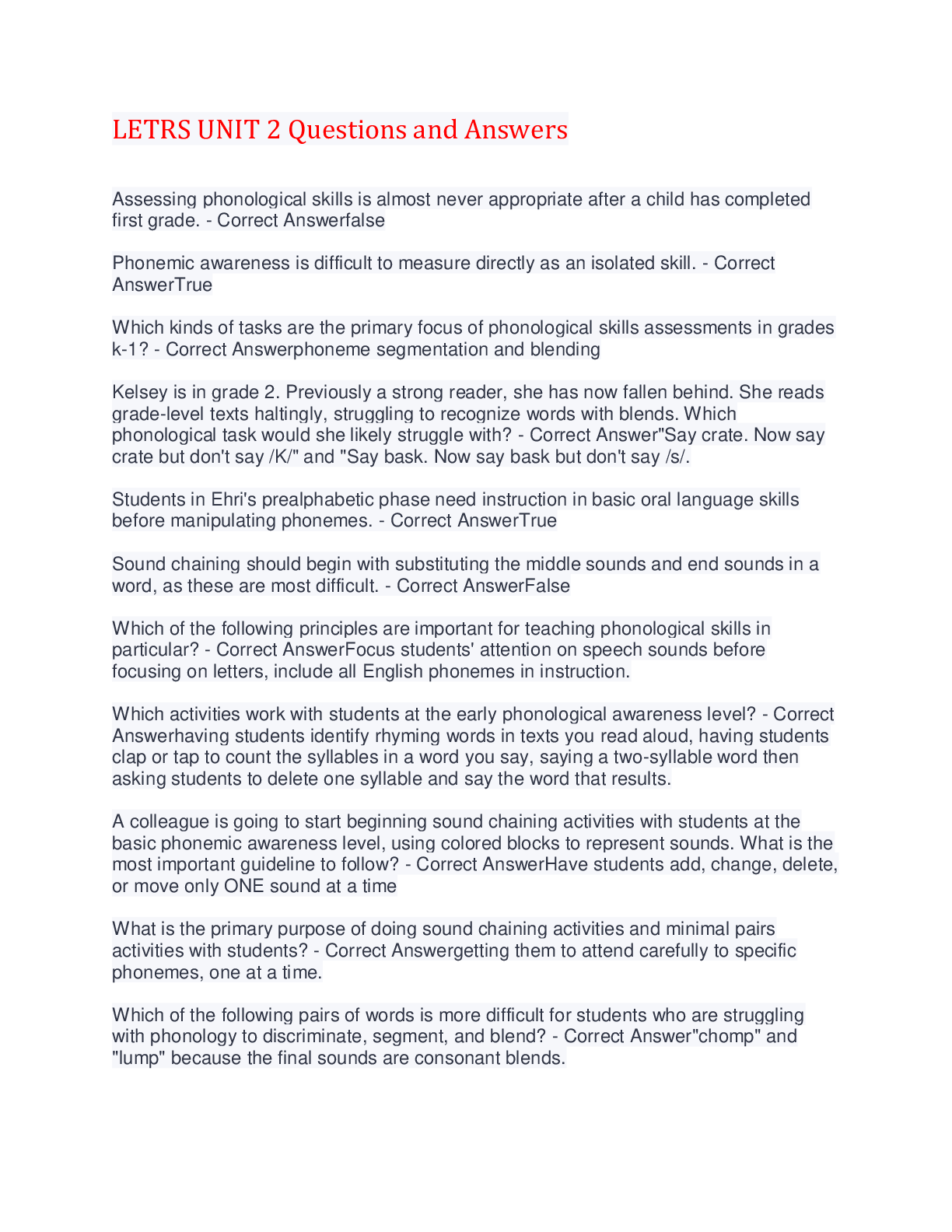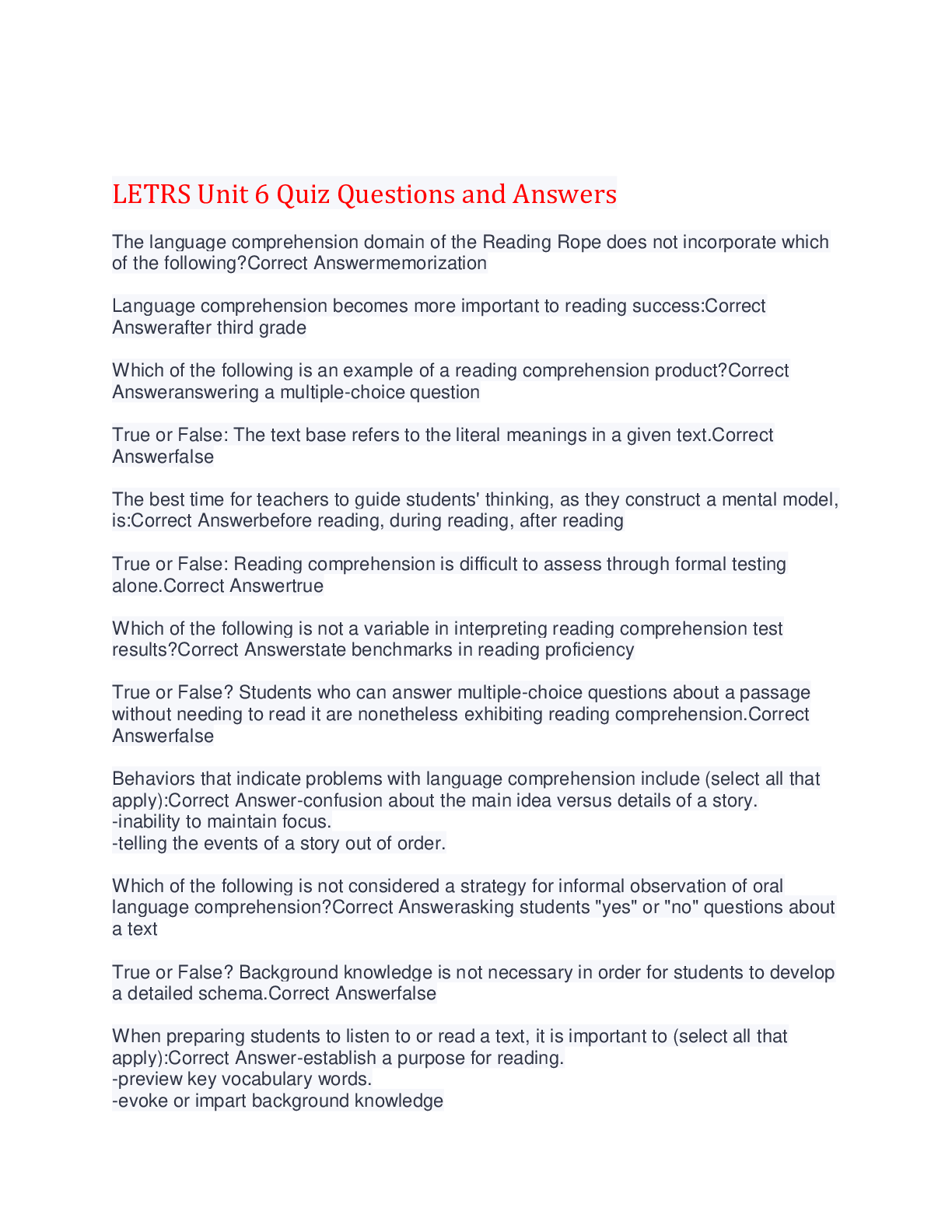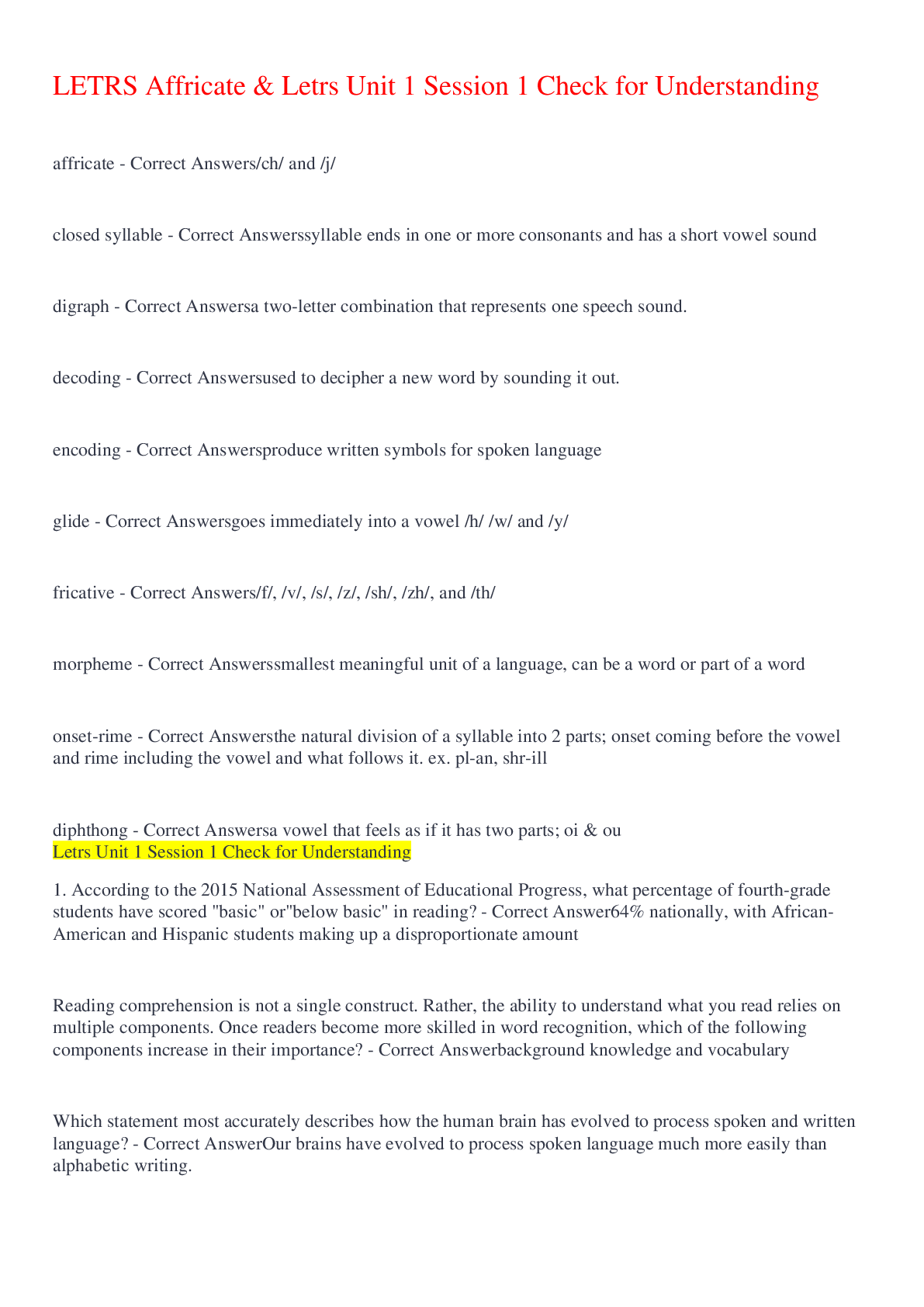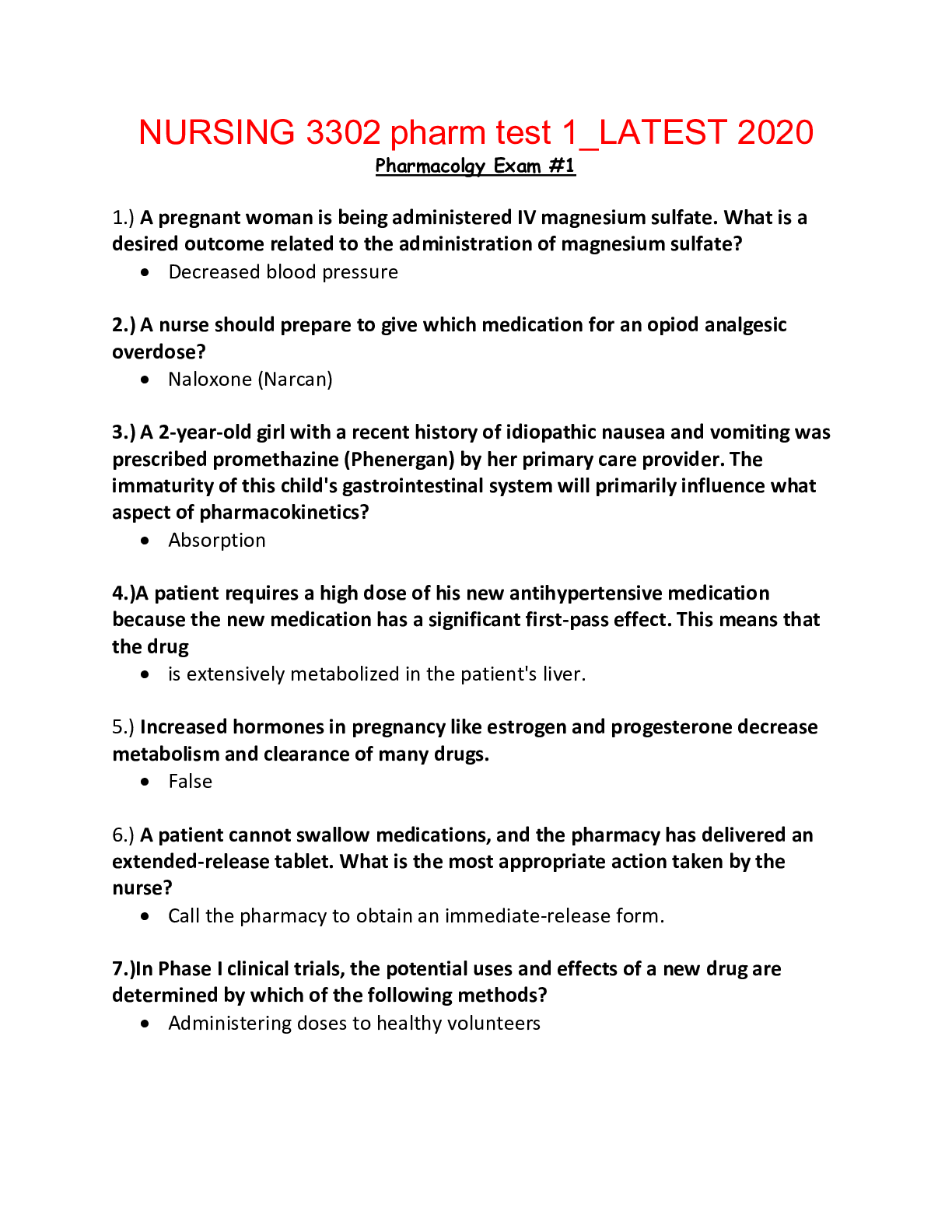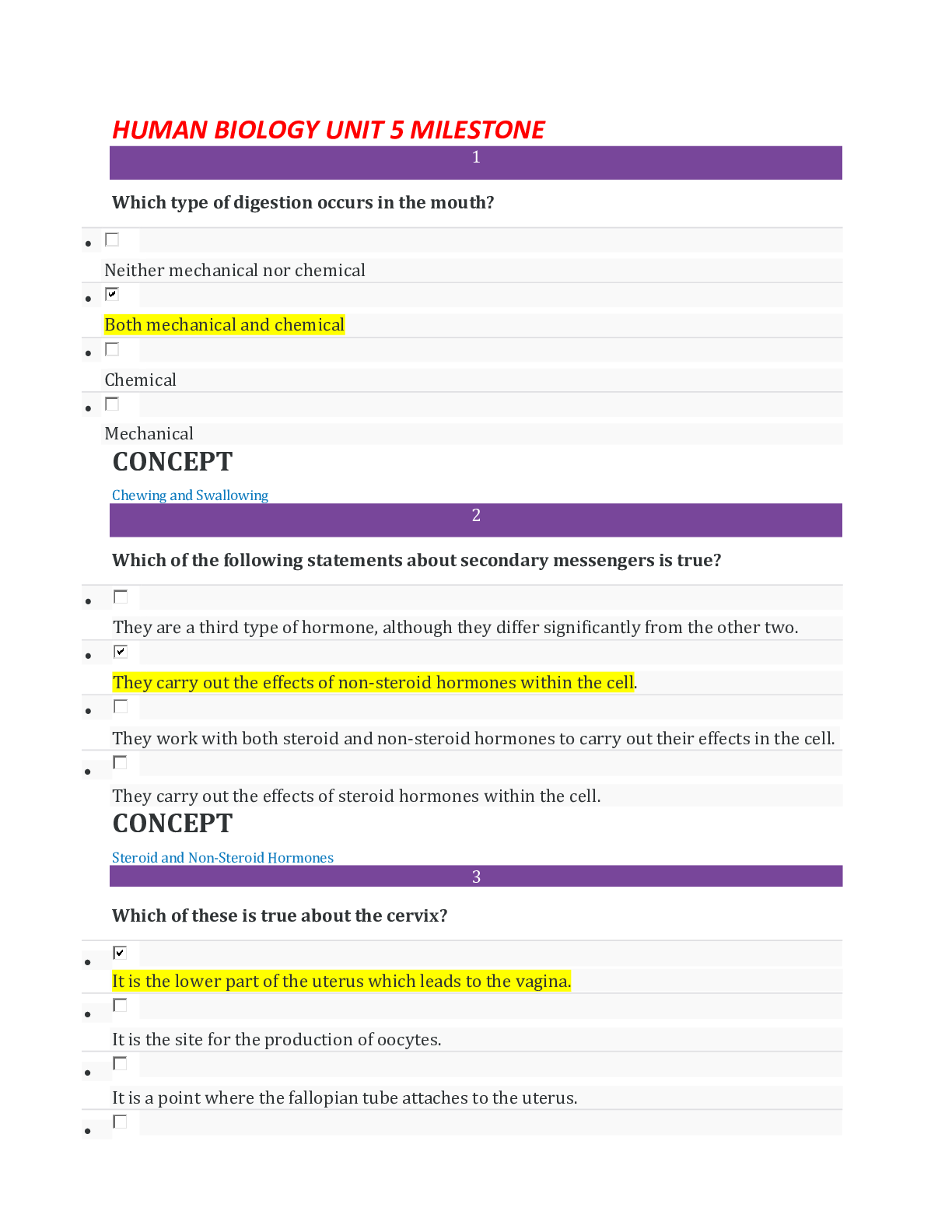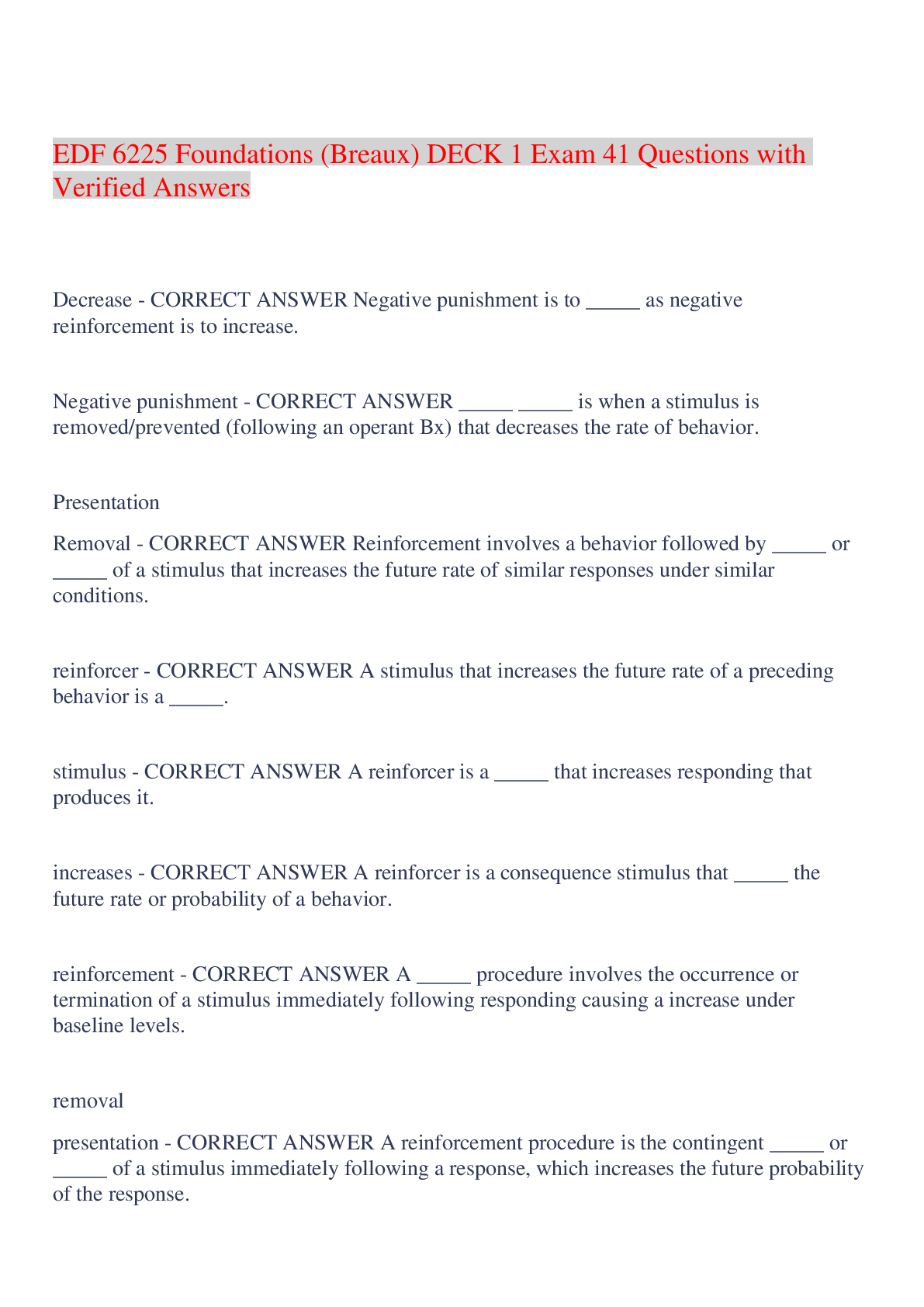*NURSING > EXAM > NUR 4013 OB exam 1 Questions and answers latest updated 2021/2022,100% CORRECT (All)
NUR 4013 OB exam 1 Questions and answers latest updated 2021/2022,100% CORRECT
Document Content and Description Below
NUR 4013 OB exam 1 Questions and answers latest updated 2021/2022 A client during her first few months of pregnancy tells the nurse, “It seems like I have to go to the bathroom every 5 minutes.�... � The nurse explains that this is due to: The growth of the uterus puts pressure on the bladder Women are sometimes very sensitive to their body functions during pregnancy A bladder infection An increase in the bladder capacity A 25-year-old primigravida is 20 weeks pregnant. At the clinic, her nurse performs a prenatal examination with vital signs. Which of the vital signs should the nurse evaluate further? Respirations 30/min Blood pressure 120/70 Pulse 80/bpm Temperature 99.3 During the initial prenatal visit, the nurse performs a psychosocial assessment. The nurse should expect the client in her first trimester to demonstrate Ambivalence regarding the pregnancy Disapproval of the woman’s partner An unlisted telephone number or no telephone Reluctance to tell the significant other of the pregnancy When performing a prenatal assessment of parenting, which of the following comments, if made by the patient, would indicate a need for further investigation? “We’ve already told our parents we’re expecting, ant the people at work too “I work and have an active social life, I don’t see how a baby will change it all that much.” “I have so much to learn about taking care of a baby. I’ve already bought a couple of books.” “When will I start to feel my baby move?” Which of the following third trimester women would the nurse suspect may be having difficulty with psychological adjustments to her pregnancy? One who: Has not investigated the kind of clothing or feeding methods the baby will need. Was a smoker, but who has quit at least for the duration of her pregnancy Says, “Either a boy or a girl will be fine with me.” Puts her feet up and listen’s to her iPod for 15 minutes. A 12 weeks gestation woman is now pregnant for the second time and tells the nurse that her first baby was born at 38 weeks and 5 days gestation. Her baby is considered to have been born: Postterm Premature C. Term D. Preterm A client comes to the clinic complaining of slight cramping. She states that her last menstrual period was 8- 12 weeks ago. The urine pregnancy test is positive. The doctor orders an ultrasound to verify the viability of the pregnancy by looking for what specific element? Fetal breathing movements B. Fetal heart activity Fetal abdominal circumference Placental location A nurse is caring for a woman who tells her she delivered her first child at 38 weeks and her second child was delivered at 40 weeks. The nurse documents the woman’s obstetrical history as a: Multigravida Nullipara Primigravida D. Multipara A pregnant patient who swims three to five times a week asks the nurse if she should stop this activity. How should the nurse respond? “You should discontinue your exercise program immediately.” “You should increase the number of times you swim each class.” “You should decrease the number of times you swim per week.” D. “Continuing your exercise program would be beneficial.” A nurse who works in the antepartum clinic is obtaining histories from several pregnant clients. Which of the following clients should the nurse schedule for alpha-fetoprotein (AFP) screening? Has had a child with spina bifida Is in preterm labor Has a cardiac anomaly Has been exposed to AIDS A 28-weeks gestation woman calls her doctors office and anxiously tells the nurse that she has not felt the baby move for over 30 minutes. The most appropriate initial comment by the nurse would be: “When did you eat last?” “Have you been smoking?” “You need to come to the clinic right away for further evaluation.” D. “Your baby may be asleep.” During a nonstress test, a nurse notes that the fetal heart rate decelerates about 15 beats during a period of fetal movement. The decelerations occur twice during the test and last 20 seconds each. The nurse realizes these results will be interpreted as A nonreactive test An equivocal test A negative test A reactive test Which of the following responses by the nurse is most appropriate to this statement: “This test isn’t my idea, but my husband insists.” “Don’t worry, everything will be fine.” “It’s your decision.” “What concerns you about this test?” “Why don’t you want to have this test?” A 39-year-old primigravida thinks that she is about 8 weeks pregnant, although she has had irregular menstrual periods all of her life. Her laboratory data are within normal limits. Which of the following diagnostic techniques should be most conclusive at this time? Amniocentesis Nonstress test C. Ultrasound D. Maternal serum alpha-fetoprotein (MSAFP) A 28-year-old Multigravida tells the nurse that she’s scheduled for a magnetic resonance imaging (MRI) procedure one week after having had an ultrasound. The nurse anticipates that the purpose of the MRI is to: Determine amniotic fluid volume Determine the gender of the fetus Confirm the presence of an abnormality Estimate the fetal gestational age A nurse is assessing a 16 year-old primigravida client who is 32 weeks pregnant. The client reports flank pain, dysuria, pelvic pressure, and backache for the past 2 days. The nurse should further evaluate the client for Placental insufficiency B. Preterm labor Symptoms of hypertension Multifetal pregnancy A patient comes to the clinic and tells the nurse that her period is 8 weeks late, but she has a negative home pregnancy test. The nurse tells the patient that the doctor will send her for diagnostic testing to assess for positive signs of pregnancy which include: SELECT ALL THAT APPLY Positive pregnancy test Amenorrhea Auscultation of fetal heart rate D. Fetal outline on ultrasound A 20 weeks gestation woman is at a local clinic for prenatal care. After reviewing the urinalysis results, which findings should the nurse evaluate further? SELECT ALL THAT APPLY Epithelials B. Glucosuria C. Bacteria in the urine D. Ketones in the urine In order to prevent dependent edema, the nurse educates the mother to: A. Elevate her legs frequently Wear antiembolism stockings Alternate sitting and standing Massage legs frequently During a pre-natal class the nurse addresses symptoms that a woman should report immediately to her health care provider. Which of the following should the nurse include in the teaching? SELECT ALL THAT APPLY Vaginal bleeding Increased vaginal secretions C. Severe headache D. Urinary frequency A 41-week pregnant multigravida presents in the labor and delivery unit after a non stress test that indicated her fetus could be experiencing some difficulties in utero. Whish of the following diagnostic evaluations should the nurse explain to the mother? Maternal serum alpha-fetal protein Percutaneous umbilical blood sampling C. Biophysical profile D. Ultrasound for the fetal anomalies A nurse is caring for a pregnant client who has congenital heart disease. The nurse plans for whish alterations in the clients diet during pregnancy? Decrease protein and increase complex carbohydrates Reduce calories and fluid intake Reduce calories and fat Caffeine and sodium and fat A pregnant client who has HBA1C level of 12% asks the nurse what the result means. The nurses best response is: You have poor glucose control during the last 8th weeks You will need to be placed on insulin as your glucose levels have been out of control for the last 48 hours You have been consuming inadequate amounts of carbohydrates and calories. This has caused and abnormal decrease in your glucose levels over the past few weeks You have been maintaining your glucose levels well with in the past 24 hours. A 14-year-old client who is 8 weeks pregnant is seeking obstetric care. Which of the following is most important for the nurse to include in the plan of care? Develop a plan to assist her in continuing her education Undergo prenatal chromosomal analysis Bring her partner to all the prenatal visits Terminate the pregnancy before the end of the first trimester A nurse is counseling a gestational diabetic client regarding the target lab values for her blood sugar. Whish of the following should the nurse include in the teaching? Fasting blood sugar < 80, postprandial of <120 and 2 hour postprandial of <140 B. Fasting blood sugar < 90, postprandial of <140 and 2 hour postprandial of <120 Fasting blood sugar < 60, postprandial of <100 and 2 hour postprandial of <120 Fasting blood sugar < 100, postprandial of <150 and 2 hour postprandial of <140 At the first antepartum visit a patient states that she feels the baby move regularly. The nurse knows that fetal movement is usually felt by: 20 weeks 26 weeks 12 weeks 15 weeks A patient in her first trimester shares with the nurse that her husband is also experiencing morning sickness. The nurse best response should be to: Explain that some expectant fathers experience similar symptoms without pathology. Refer the patient and her husband to psychiatric counseling Refer the patient and her husband to gastroenterologist Explain that these are flu –like symptoms and encourage the pregnant patient to isolate herself. A nurse is obtaining a history from a pregnant client during the first prenatal visit. The client states that her last menstrual period occur on April 11th. The nurse correctly calculated the estimated date of birth (EDB) for this client as January 25 February 14 January 4 D. January 18 A prima-gravida at 32 weeks gestation present to triage with complains of intermittent calf pain. The nurse begins the assessment by instructing the client to: Dorsiflexion of the foot Apply a warm pack Massage the affected muscle Stretch and point the toe While the nurse is assessing the vital signs of a pregnant woman in her 3 trimester the client reports feeling faint, dizzy, and agitated. Whish nursing intervention is appropriate? Have the patient lie supine for 5 minutes and recheck her blood pleasure on both arms Have the client stand up and retake her blood pressure Have the patient turn to her left side and recheck her BP in 5 minutes Have the patient sit down and hold her arm in a dependent position During the first prenatal visit, and 8th week gestation client reports morning sickness. To promote self care, the nurse suggest to the client that the nausea can be relieved by Avoiding carbonated beverages. B. Eating small frequent meals Intake of spicy food Avoid eating until two hours after rising A pregnant client in her first trimester asks the nurse about normal weight gain during pregnancy. 15 to 25 pounds B. 25 to 35 pounds 28 to 40 pounds Less than 15 pounds A pregnant woman comes to the emergency department reporting nasal congestion and epistaxis. The woman asks what causes this to occur. Whish of the following explanations should the nurse give to the client. Estrogen causes increased blood supply to the mucous membranes and can result in congestion and nosebleeds. Estrogen relaxes the smooth muscles in the respiratory track, so congestion and epistaxis are with in normal limits. These conditions are abnormal. Refer client to ear, nose and throat specialist Nasal stuffiness and nosebleeds are caused by decrease in progesterone. The capacity of the uterus in term pregnancy is how many times its pre-pregnant size? A. 300 B. 500 C. 100 D. 200 Whish of the following terms is appropriate for a client whose obstetric history includes a current pregnancy and one elective abortion at 10 weeks? Multipara Multigravida Primigravida Primipara A client notices that the doctor writes “positive Chadwick’s sign” on her chart. The client asks the nurse what this means. How should the nurse respond? “The doctor was able to flex the uterus against the cervix.” “This refers to a positive sign of pregnancy.” “It refers to the bluish color of the cervix in pregnancy.” “It means the cervix is softening.” Determine the gravida and para for a client, who delivered triplets 2 years ago and is now pregnant again. Gravida 1 Para 2 Gravida 1 Para 3 Gravida 2 Para 3 D. Gravida 2 Para 1 A certified nurse midwife (CNM) is conducting a teaching session on anticipatory guidance for women during the first trimester of pregnancy. The CNM should focus on increasing the pregnant woman’s knowledge of: Physical and psychological changes resulting from pregnancy. Role transition into parenthood. The unpredictability of the labor and delivery process. Signs of complications. At the first prenatal visit the pregnant woman tells the nurse that she works at a computer entering data. Considering the implications during pregnancy, the nurse should recommend: Telling her employer she cannot work beyond the second trimester. Asking for time in the morning and afternoon to obtain nourishment. C. Walking every few hours during the workday. D. Asking for time in the morning and afternoon to elevate her legs. A nurse is performing an antepartal assessment on a client in her first trimester. Which of the following client manifestations should require immediately attention? Urinary frequency Nausea with occasional vomiting C. Vaginal bleeding D. Fatigue A nurse is caring for a 24-weeks’ gestation women who has gestational hypertension. Which of the following blood pressure assessment findings would indicate that the client is at risk for developing preeclampsia? Baseline BP 140/85, current BP 130/80 B. Baseline BP 100/70, current BP 130/85 Baseline BP 120/80, current BP 126/85 Baseline BP 110/60, current BP 110/60 An intervention for the client who is experiencing nausea and vomiting is to: Avoid eating immediately before bedtime. Increase fluid intake with meals. C. Eat five to six small meals a day. D. Decrease carbohydrates. Early pregnancy classes offered in the first and second trimesters cover: Methods of pain relief Coping with common discomforts of pregnancy Phases and stages of labor. Predelivery and postdelivery care of the client having a cesarean section. A pregnant client’s mother is worried that her daughter is not big enough at 20 weeks. The nurse palpates and measures the fundal height at 20 cm, which is even with the womans umbilicus. What should the nurse report to the client and her mother? “When you come for next month’s appointment, we’ll check you again to make sure the baby is growing.” B. “The body of the uterus is at the belly button level, just where it should be at this time.” “Lightening has occurred, so the fundal height is lower than expected.” “You’re so right. We’ll inform the practitioner immediately.” A woman in her first trimester of pregnancy would expect to visit her physician every 4 weeks so that: Her questions about labor can be answered. Problems can be eliminated She develops trust in the healthcare team. The condition of the expectant mother and fetus can be monitored. The antepartum nurse teaches clients to elevate the legs frequently because pelvic and femoral vessel pressure caused by the enlarged uterus can lead to: Varicosities, hypertension and nausea Hemorrhoids, hypotension, and vomiting Hypotension, nausea, and vomiting Dependent edema, varicosities, and hemorrhoids A client expresses her ambivalence about her pregnancy to the nurse. The nurse’s best response should be to: Explain that most woman experience some ambivalence in early pregnancy Document the findings and reassess at the next prenatal visit Explain that when she experiences quickening the ambivalence will resolve Refer her to counseling regarding her ambivalence to pregnancy A 32-week multipara presents to the clinic for a routine visit. Whish of the following if expressed by the client should require immediate follow up by the nurse. Alteration in patter of fetal movement Edema in the ankles and feet at the end of the day Constipation Heart palpitations A client who has a history of false positive pregnant test asks the nurse, “How would I know if I am truly pregnant this time”. The nurse explains that the diagnosis of pregnancy is base on the following positive sings. SELECT ALL THAT APPLY Identification of fetal heartbeat B. Palpation of the fetal outline Visualization of the fetus Fetal movement felt by the mother Positive hCG test A primigravida is 23 weeks gestation. Whish of the following physical assessment findings would necessitate referral for further investigation. Minimal ankle edema Odorless, cloudy, mucoid vaginal discharge Striae gravidarum Fundus palpated slightly below the umbilicus A nurse is caring for a 36-weeks gestation client who has just had an eclamptic seizure and is now comatose. Whish of the following interventions should be a priority for this client? Position the client on her side Start IV fluids of D5LR Position the client in Trendelenberg’s position Elevate the head of the bed to 90 degrees The patient schedule for a non stress test (NST) asks the nurse why this test needs to be done. What is the nurse best response? The test determents how well your placenta is functioning B. The test how your baby heart rate reacts to movement This test helps to determines the amount of amniotic fluid surrounding your baby This test determines how mature your baby’s lungs are During pregnancy class the nurse educator is asked about sexual intercourse during pregnancy. Whish should the nurse include in her response. SELECT ALL THAT APPLY Intercourse and orgasm should be avoided during the 3rd trimester B. As your abdomen enlarges, you may need to try alternate positions C. You should avoid intercourse or orgasms if your membranes have ruptured D. You may find that you have an increase sexual desire during pregnancy A nurse is caring for a pregnant client who has epilepsy. The client ask the nurse about taking the prescribe anti-epileptic drug during this time. The nurse should explain that SELECT ALL THAT APPLY Anti-seizure medications can cause fetal anomalies Anti-seizure medications are teratogenic Anti-seizure medications should no be taken during pregnancy as seizures do not pose a thread to the fetus. Anti-seizure medications should be taken during pregnancy as seizures pose a significant threat to the fetus A young couple is at the doctors office because the wife is 8-weeks pregnant. They ask the clinic nurse for information about an abortion. The nurse expresses the opinion that abortion is immoral and that many woman have long-term guilt feelings after an abortion. The couple leaves the clinic in a very disturbed state. Legally the Patient had the right to receive correct unbiased information Nurse had a right to state feelings as long as they were identified as the nurses own. Physician should have been called in, since nurses should not discuss abortion Nurse’s statement need not to be based on scientific knowledge. At 10 weeks gestation, a client completely expels the products of conception. Because the client is Rh- negative, a priority action for the nurse at this time is to: Not give RhoGam, since it is not used with birth of a stillborn Make certain the patient does not receive RhoGam, since the gestation lasted only 12 weeks. C. Administer RhoGam within 72 hours D. Make certain she receives RhoGam on her first clinic visit Most spontaneous abortions are caused by: Embryonic cell defects Congenital defects Physical trauma Unresolved stress A 42- year- old woman who is concerned about Downs Syndrome Has an amniocentesis at 16 weeks gestation. Examination of the amniotic fluid will also provide information regarding: Fetal lung maturity Fetal diabetes Presence of neural tube defects Cardiac anomalies A pregnant client asks the clinic nurse how smoking will affect her baby. The nurse’s response reflects the knowledge that: Vasoconstriction will affect both fetal and maternal blood vessels Fetal and maternal circulation are separated by the placental barrier The placenta is permeable to specific substances Smoking relives tension and fetus responds accordingly A nurse is obtaining a history from a pregnant client making her first antepartum visit. The client has a 2- year old daughter born at 40 weeks, a 5-year-old son born at 38 weeks, and 7-years-old twin daughters born at 35 weeks. She had a spontaneous abortion 3 years ago at 10 weeks. Using the GTPAL format, the nurse identifies that the client is: G5T2P1A1L4 G4T3P1A1L4 G4T3P2A1L4 D. G5T2P2A1L4 [Show More]
Last updated: 2 years ago
Preview 1 out of 11 pages
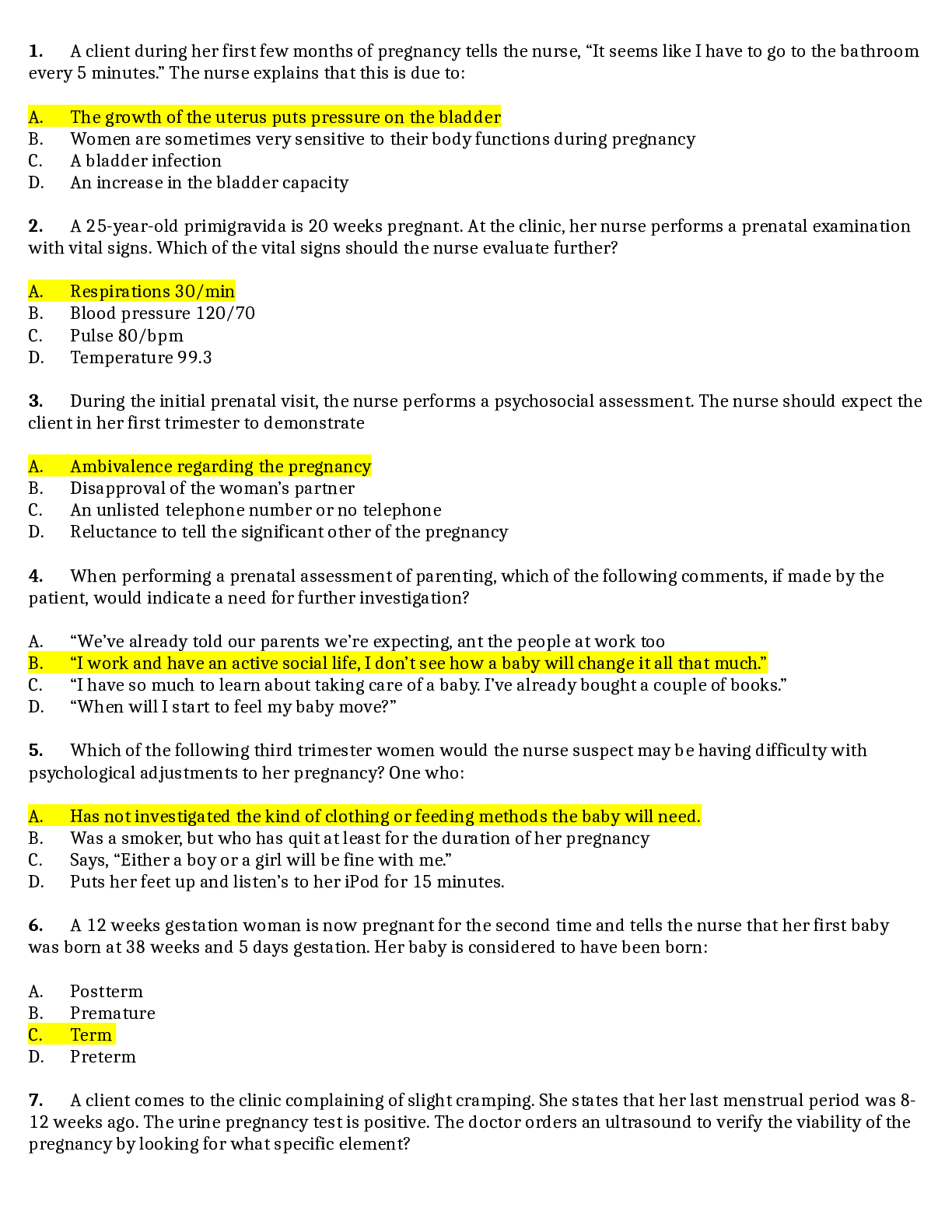
Buy this document to get the full access instantly
Instant Download Access after purchase
Buy NowInstant download
We Accept:

Reviews( 0 )
$16.00
Can't find what you want? Try our AI powered Search
Document information
Connected school, study & course
About the document
Uploaded On
Feb 23, 2022
Number of pages
11
Written in
Additional information
This document has been written for:
Uploaded
Feb 23, 2022
Downloads
0
Views
73


